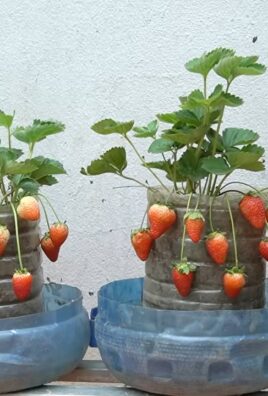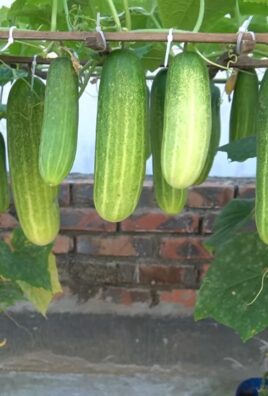Growing Turnips at Home might sound like something your grandparents did, but trust me, this root vegetable is making a serious comeback! Forget those bland, store-bought turnips – imagine pulling crisp, slightly sweet turnips straight from your own backyard. Sounds delicious, right?
For centuries, turnips have been a staple in diets across the globe, from humble peasant fare to surprisingly elegant dishes. Their resilience and nutritional value made them a vital crop, especially during leaner times. But beyond their historical significance, why should you be interested in growing turnips at home today?
Well, for starters, they’re incredibly easy to grow, even for beginner gardeners. Plus, homegrown turnips offer a flavor that’s simply unmatched by anything you’ll find in the supermarket. And let’s be honest, there’s something incredibly satisfying about nurturing your own food from seed to table. In this article, I’m going to share some of my favorite DIY tricks and hacks to help you master the art of growing turnips at home, ensuring a bountiful harvest and a delicious addition to your meals. Get ready to get your hands dirty – it’s time to grow some turnips!

Growing Turnips: A Beginner’s Guide to a Bountiful Harvest
Hey there, fellow gardening enthusiasts! I’m so excited to share my experience with growing turnips. These root vegetables are surprisingly easy to cultivate, even if you’re a complete beginner like I was not too long ago. They’re packed with nutrients, delicious in so many dishes, and offer a quick turnaround from planting to harvest. Let’s dive into how you can grow your own turnips at home!
Choosing the Right Turnip Variety
Before we get our hands dirty, let’s talk about turnip varieties. There are a bunch to choose from, each with its own unique characteristics.
* **Purple Top White Globe:** This is a classic and popular choice. It’s known for its mild flavor and smooth, white flesh with a purple top. It’s a reliable grower and a good all-around option.
* **Tokyo Cross:** If you’re looking for a super-fast harvest, Tokyo Cross is your friend. These turnips mature incredibly quickly, often in just 30 days! They have a mild, sweet flavor and are great for salads.
* **Golden Ball:** As the name suggests, these turnips have a beautiful golden-yellow flesh. They have a slightly sweeter flavor than Purple Top White Globe and are excellent roasted.
* **Hakurei:** This Japanese turnip is another quick-maturing variety. It’s known for its delicate flavor and tender texture. You can even eat the greens!
I personally love growing Purple Top White Globe because they are so versatile, but feel free to experiment and find your favorite!
Preparing Your Turnip Patch
Turnips thrive in well-drained soil that’s rich in organic matter. Here’s how I prepare my turnip patch:
* **Sunlight:** Turnips need at least 6 hours of sunlight per day. Choose a spot in your garden that gets plenty of sunshine.
* **Soil Testing:** It’s always a good idea to test your soil’s pH. Turnips prefer a slightly acidic soil with a pH between 6.0 and 6.8. You can buy a soil testing kit at most garden centers.
* **Soil Amendment:** Amend your soil with compost or well-rotted manure to improve drainage and fertility. I usually add a generous layer of compost and work it into the top 6-8 inches of soil.
* **Loosening the Soil:** Use a garden fork or tiller to loosen the soil. This will make it easier for the turnip roots to grow.
* **Removing Rocks and Debris:** Remove any rocks, roots, or other debris from the soil. This will prevent the turnip roots from being deformed.
Planting Turnip Seeds
Now for the fun part – planting! Turnips are cool-season crops, so the best time to plant them is in the spring or fall.
* **Timing:** For a spring crop, plant your turnip seeds 2-4 weeks before the last expected frost. For a fall crop, plant them 6-8 weeks before the first expected frost.
* **Sowing Seeds:** Sow the seeds directly into the prepared soil. Plant them about ½ inch deep and 1 inch apart.
* **Row Spacing:** Space your rows about 12-18 inches apart.
* **Watering:** Gently water the soil after planting. Keep the soil consistently moist until the seeds germinate.
* **Thinning:** Once the seedlings emerge, thin them to about 3-4 inches apart. This will give the turnips enough room to grow. Don’t throw away the thinnings! You can eat the young turnip greens in salads.
Caring for Your Turnip Plants
Turnips are relatively low-maintenance, but here are a few things you can do to help them thrive:
* **Watering:** Water your turnip plants regularly, especially during dry spells. Aim for about 1 inch of water per week.
* **Weeding:** Keep the area around your turnip plants free of weeds. Weeds can compete with the turnips for nutrients and water. I like to hand-weed regularly to prevent weeds from getting out of control.
* **Fertilizing:** Turnips don’t need a lot of fertilizer, but you can give them a boost with a side dressing of compost or a balanced fertilizer a few weeks after they emerge.
* **Pest Control:** Keep an eye out for pests like aphids, flea beetles, and cabbage worms. You can control these pests with insecticidal soap or neem oil. I prefer using organic pest control methods whenever possible.
* **Crop Rotation:** Practice crop rotation to prevent soilborne diseases. Don’t plant turnips in the same spot year after year.
Harvesting Your Turnips
The moment we’ve all been waiting for – harvest time! Turnips are ready to harvest when the roots are about 2-3 inches in diameter.
* **Timing:** The time to harvest depends on the variety you planted. Some varieties, like Tokyo Cross, mature in as little as 30 days, while others may take 50-60 days.
* **Harvesting:** Gently loosen the soil around the turnip with a garden fork. Then, grasp the turnip greens near the base and pull the turnip out of the ground.
* **Cleaning:** Brush off any excess soil from the turnips.
* **Storing:** Store your turnips in a cool, dark place. You can store them in the refrigerator for several weeks. Cut off the greens before storing, as they will draw moisture from the roots. The greens can be stored separately in the refrigerator for a few days.
Enjoying Your Homegrown Turnips
Now that you’ve harvested your turnips, it’s time to enjoy them! Turnips are incredibly versatile and can be used in a variety of dishes.
* **Raw:** Young, tender turnips can be eaten raw in salads or as a snack. They have a slightly peppery flavor.
* **Roasted:** Roasting turnips brings out their sweetness. Toss them with olive oil, salt, and pepper, and roast them in the oven until they’re tender and slightly caramelized.
* **Mashed:** Mashed turnips are a delicious and healthy alternative to mashed potatoes.
* **Soups and Stews:** Turnips add a hearty flavor to soups and stews.
* **Turnip Greens:** Don’t forget about the turnip greens! They’re packed with nutrients and can be cooked like spinach or kale. Sauté them with garlic and olive oil for a simple and delicious side dish.
Troubleshooting Common Turnip Problems
Even with the best care, you might encounter some problems while growing turnips. Here are a few common issues and how to address them:
* **Bolting:** Bolting is when the turnip plants flower prematurely. This can happen if the weather gets too hot or if the plants are stressed. To prevent bolting, plant your turnips at the right time of year and keep them well-watered.
* **Root Maggots:** Root maggots are small, white larvae that feed on the turnip roots. They can cause the roots to become deformed and stunted. To prevent root maggots, practice crop rotation and use row covers to protect your plants.
* **Clubroot:** Clubroot is a soilborne disease that causes the turnip roots to become swollen and distorted. To prevent clubroot, practice crop rotation and amend your soil with lime to raise the pH.
* **Flea Beetles:** Flea beetles are small, jumping insects that feed on the turnip leaves. They can cause small holes in the leaves. To control flea beetles, use insecticidal soap or neem oil.
Step-by-Step Guide: From Seed to Table
Let’s break down the entire process into a simple, numbered guide:
1. **Choose Your Variety:** Select the turnip variety that best suits your taste and growing conditions.
2. **Prepare Your Soil:** Find a sunny spot, test your soil, and amend it with compost. Loosen the soil and remove any rocks or debris.
3. **Plant Your Seeds:** Sow the seeds directly into the prepared soil, about ½ inch deep and 1 inch apart.
4. **Water Regularly:** Keep the soil consistently moist until the seeds germinate.
5. **Thin Seedlings:** Once the seedlings emerge, thin them to about 3-4 inches apart.
6. **Weed Regularly:** Keep the area around your turnip plants free of weeds.
7. **Fertilize (Optional):** Give your plants a boost with a side dressing of compost or a balanced fertilizer a few weeks after they emerge.
8. **Monitor for Pests and Diseases:** Keep an eye out for common turnip problems and take action to control them.
9. **Harvest Your Turnips:** Harvest when the roots are about 2-3 inches in diameter.
10. **Enjoy Your Harvest:** Eat your turnips raw, roasted, mashed, or in soups and stews. Don’t forget the greens!
Final Thoughts
Growing turnips is a rewarding experience. With a little bit of planning and effort, you can enjoy a bountiful harvest of these delicious and nutritious root vegetables. So,

Conclusion
So, there you have it! Growing turnips at home is not only achievable, but it’s also a deeply rewarding experience that connects you directly to your food source. Forget those bland, store-bought turnips that lack the vibrant flavor and crisp texture of freshly harvested ones. With a little planning and effort, you can cultivate a bountiful crop of these versatile root vegetables right in your own backyard, or even in containers on your balcony.
The beauty of this DIY project lies in its simplicity and adaptability. Whether you’re a seasoned gardener or a complete novice, the steps outlined above are easy to follow and can be tailored to suit your specific climate and growing conditions. Remember, the key to success is consistent watering, well-drained soil, and protection from pests.
But don’t stop there! Experiment with different varieties of turnips to discover your personal favorites. From the mild and sweet ‘Tokyo Cross’ to the peppery ‘Purple Top White Globe,’ there’s a turnip out there for every palate. Consider companion planting with other vegetables like radishes or carrots to deter pests and improve soil health. You can even use the turnip greens in salads or stir-fries for an extra boost of nutrients.
Growing turnips at home offers a unique opportunity to control the quality of your food and reduce your reliance on commercial agriculture. You’ll know exactly what went into your turnips, from the type of soil to the amount of fertilizer used (or not used, if you prefer organic methods). This level of control is especially important for those who are concerned about pesticides and other harmful chemicals.
Beyond the practical benefits, growing your own turnips is also a fun and educational activity for the whole family. Get your kids involved in the planting, watering, and harvesting process, and teach them about the wonders of nature and the importance of sustainable living. It’s a great way to spend quality time together and create lasting memories.
We strongly encourage you to give this DIY trick a try. You’ll be amazed at how easy and rewarding it is to grow your own turnips. And once you’ve harvested your first crop, don’t forget to share your experience with us! We’d love to hear about your successes, challenges, and favorite turnip recipes. Post photos of your garden, share your tips and tricks, and inspire others to join the growing movement of home gardeners. Let’s create a community of turnip enthusiasts who are passionate about fresh, healthy, and sustainable food.
So, grab your gardening gloves, prepare your soil, and get ready to embark on a delicious and fulfilling adventure. Happy growing!
Frequently Asked Questions (FAQ)
What is the best time of year to plant turnips?
The best time to plant turnips depends on your climate. In general, turnips are a cool-season crop, meaning they thrive in cooler temperatures. For a spring harvest, plant turnips 4-6 weeks before the last expected frost. For a fall harvest, plant turnips 6-8 weeks before the first expected frost. In warmer climates, you can plant turnips throughout the fall and winter. Check your local extension office for specific planting dates in your area.
What kind of soil do turnips need?
Turnips prefer well-drained, fertile soil with a pH between 6.0 and 6.8. Amend heavy clay soil with compost or other organic matter to improve drainage. If your soil is sandy, add compost to help retain moisture. Before planting, work in a balanced fertilizer or compost to provide essential nutrients. A soil test can help you determine the specific nutrient needs of your soil.
How much sunlight do turnips need?
Turnips need at least 6 hours of sunlight per day to grow properly. Choose a planting location that receives full sun for best results. If you’re growing turnips in containers, make sure to place them in a sunny spot. Insufficient sunlight can lead to leggy growth and reduced yields.
How often should I water turnips?
Turnips need consistent moisture to thrive. Water deeply and regularly, especially during dry periods. Aim to keep the soil consistently moist but not waterlogged. Overwatering can lead to root rot. A good rule of thumb is to water when the top inch of soil feels dry to the touch. Mulching around the plants can help retain moisture and suppress weeds.
What are some common pests and diseases that affect turnips?
Common pests that affect turnips include aphids, flea beetles, and root maggots. Aphids can be controlled with insecticidal soap or neem oil. Flea beetles can be deterred by covering plants with row covers. Root maggots can be prevented by rotating crops and using diatomaceous earth. Common diseases that affect turnips include clubroot and powdery mildew. Clubroot can be prevented by maintaining a proper soil pH and rotating crops. Powdery mildew can be controlled with fungicides.
How long does it take for turnips to mature?
Turnips typically mature in 50-60 days, depending on the variety. Some varieties, like ‘Tokyo Cross,’ can mature in as little as 30 days. You can harvest the roots when they reach the desired size. The greens can be harvested at any time.
Can I eat turnip greens?
Yes, turnip greens are edible and nutritious. They are a good source of vitamins A, C, and K, as well as calcium and fiber. Turnip greens can be eaten raw in salads or cooked like spinach or kale. They have a slightly peppery flavor.
How do I store turnips?
To store turnips, cut off the greens, leaving about an inch of stem. Wash the turnips and dry them thoroughly. Store them in a cool, dark, and humid place, such as a root cellar or refrigerator. Turnips can be stored for several months under the right conditions.
Can I grow turnips in containers?
Yes, turnips can be grown in containers. Choose a container that is at least 12 inches deep and wide. Use a well-draining potting mix. Water regularly and fertilize every few weeks. Make sure the container receives at least 6 hours of sunlight per day.
What are some good companion plants for turnips?
Good companion plants for turnips include radishes, carrots, onions, garlic, and marigolds. Radishes and carrots help break up the soil and deter pests. Onions and garlic repel pests. Marigolds attract beneficial insects. Avoid planting turnips near mustard or other brassicas, as they can attract the same pests and diseases.
How do I know when my turnips are ready to harvest?
Turnips are ready to harvest when the roots reach the desired size. Check the seed packet for the expected size of the mature turnips. You can also gently dig around the base of the plant to check the size of the root. The greens can be harvested at any time, but they are most tender when they are young.
What are some different ways to cook turnips?
Turnips can be cooked in a variety of ways. They can be roasted, boiled, mashed, steamed, or stir-fried. They can also be added to soups and stews. Turnip greens can be sautéed, steamed, or added to salads.
Are there different varieties of turnips?
Yes, there are many different varieties of turnips, each with its own unique flavor and texture. Some popular varieties include ‘Tokyo Cross,’ ‘Purple Top White Globe,’ ‘Golden Ball,’ and ‘Hakurei.’ Experiment with different varieties to find your favorites.
What if my turnips are bitter?
Turnips can sometimes be bitter, especially if they are grown in hot weather or if they are not watered properly. To reduce bitterness, harvest turnips when they are young and tender. You can also soak turnips in cold water for a few hours before cooking them. Adding a little sugar or vinegar to the cooking water can also help reduce bitterness.




Leave a Comment